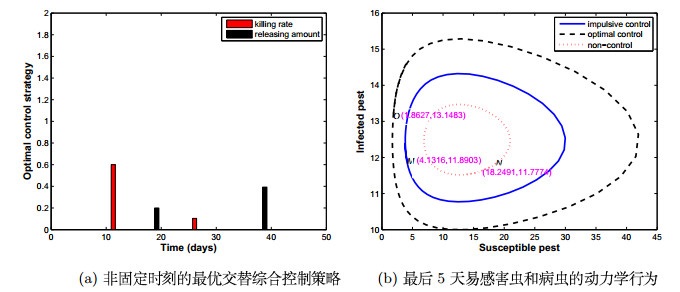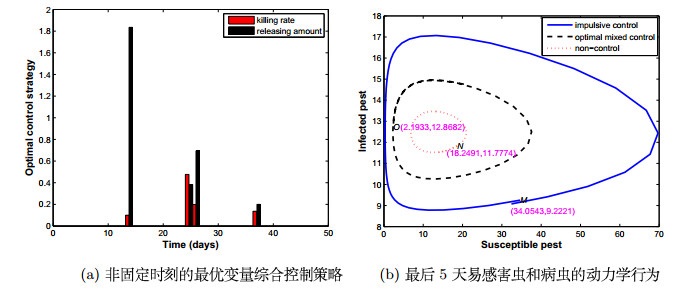Acta mathematica scientia,Series A ›› 2019, Vol. 39 ›› Issue (3): 689-704.
The Optimal Strategies of SI Pest Control Models with Impulsive Intervention
Miaomiao Chen,Yongzhen Pei*( ),Xiyin Liang,Yunfei Lv
),Xiyin Liang,Yunfei Lv
- School of science, Tianjin Polytechnic University, Tianjin 300387
-
Received:2017-05-16Online:2019-06-26Published:2019-06-27 -
Contact:Yongzhen Pei E-mail:yongzhenpei@163.com -
Supported by:the NSFC(11471243)
CLC Number:
- O193
Cite this article
Miaomiao Chen,Yongzhen Pei,Xiyin Liang,Yunfei Lv. The Optimal Strategies of SI Pest Control Models with Impulsive Intervention[J].Acta mathematica scientia,Series A, 2019, 39(3): 689-704.
share this article
| 1 |
Pei Y , Ji X , Li C . Pest regulation by means of continuous and impulsive nonlinear controls. Math Comput Model, 2010, 51: 810- 822
doi: 10.1016/j.mcm.2009.10.013 |
| 2 | Pei Y , Li C , Fan S . A mathematical model of a three species prey-predator system with impulsive control and holling functional response. Appl Math Comput, 2013, 219: 10945- 10955 |
| 3 |
Barclay H . Combining methods of pest control:Minimizing cost during the control program. Theor Popul Biol, 1991, 40: 105- 123
doi: 10.1016/0040-5809(91)90048-K |
| 4 |
Tang S , Cheke R . Models for integrated pest control and their biological implications. Math Biosci, 2008, 215: 115- 125
doi: 10.1016/j.mbs.2008.06.008 |
| 5 | Lenteren J . Success in Biological Control of Arthropods by Augmentation of Natural Enemies. Berlin: Springer, 2000 |
| 6 |
Naranjo S , Ellsworth P , Frisvold G . Economic value of biological control in integrated pest management of managed plant systems. Annu Rev Entomol, 2015, 60: 621- 645
doi: 10.1146/annurev-ento-010814-021005 |
| 7 |
Molnar S , LaPez I , Gamez M , Garay J . A two-agent model applied to the biological control of the sugarcane borer (diatraea saccharalis) by the egg parasitoid trichogramma galloi and the larvae parasitoid cotesia flavipes. Biosystems, 2016, 141: 45- 54
doi: 10.1016/j.biosystems.2016.02.002 |
| 8 |
Song Y , Pei Y , Chen M , Zhu M . Translation, solving scheme, and implementation of a periodic and optimal impulsive state control problem. Adv Differ Equ-Ny, 2018, 2018: 1- 20
doi: 10.1186/s13662-017-1452-3 |
| 9 | Jiao J , Chen L . A pest management SI model with periodic biological and chemical control concern. Appl Math Comput, 2006, 183: 1018- 1026 |
| 10 |
Wang L , Chen L , Nieto J . The dynamics of an epidemic model for pest control with impulsive effect. Nonlinear Anal-Real, 2010, 11: 1374- 1386
doi: 10.1016/j.nonrwa.2009.02.027 |
| 11 | Xiang Z . Dynamic analysis of a SI system with periodic biological and chemical control. Applied Mathematical Sciences, 2009, 3: 2327- 2334 |
| 12 |
Shi R , Jiang X , Chen L . A predator-prey model with disease in the prey and two impulses for integrated pest management. Appl Math Model, 2009, 33: 2248- 2256
doi: 10.1016/j.apm.2008.06.001 |
| 13 |
Zhang H , Xu W , Chen L . A impulsive infective transmission SI model for pest control. Math Method Appl Ssi, 2007, 30: 1169- 1184
doi: 10.1002/(ISSN)1099-1476 |
| 14 |
Jiao J , Chen L , Cai S . Impulsive control strategy of a pest management model with nonlinear incidence rate. Appl Math Model, 2009, 33: 555- 563
doi: 10.1016/j.apm.2007.11.021 |
| 15 |
Tan Y , Chen L . Modelling approach for biological control of insect pest by releasing infected pest. Chaos Soliton Fract, 2009, 39: 304- 315
doi: 10.1016/j.chaos.2007.01.098 |
| 16 |
Shi R , Chen L . An impulsive predator-prey model with disease in the prey for integrated pest management. Commun Nonlinear Sci, 2010, 15: 421- 429
doi: 10.1016/j.cnsns.2009.04.001 |
| 17 |
Liu B , Wang Y , Kang B . Dynamics on a pest management SI model with control strategies of different frequencies. Nonlinear Anal-Hybri, 2014, 12: 66- 78
doi: 10.1016/j.nahs.2013.11.006 |
| 18 |
Meng X , Song Z , Chen L . A new mathematical model for optimal control strategies of integrated pest management. J Biol Syst, 2007, 15: 219- 234
doi: 10.1142/S0218339007002143 |
| 19 | Ding Y , Gao S , Liu Y , Lan Y . A pest management epidemic model with time delay and stage-structure. Applied Mathematics, 2010, 1: 216- 221 |
| 20 |
Zhang T , Meng X , Song Y , Zhang T . A stage-structured predator-prey SI model with disease in the prey and impulsive effects. Math Model Anal, 2013, 18: 505- 528
doi: 10.3846/13926292.2013.840866 |
| 21 | Xiang Z , Tang S , Xiang C , Wu J . On impulsive pest control using integrated intervention strategies. Appl Math Comput, 2015, 269: 930- 946 |
| 22 |
Wang X , Tao Y , Song X . Analysis of pest-epidemic model by releasing diseased pest with impulsive transmission. Nonlinear Dynam, 2011, 65: 175- 185
doi: 10.1007/s11071-010-9882-4 |
| 23 |
Guan H . Aperiodic solution mathematical model for pest management and optimization chemical control. Adv Mater Res, 2014, 1079-1080: 660- 663
doi: 10.4028/www.scientific.net/AMR.1079-1080 |
| 24 |
Jiao J , Chen L . Nonlinear incidence rate of a pest management SI model with biological and chemical control concern. Appl Math Mech-Engl, 2007, 28: 541- 551
doi: 10.1007/s10483-007-0415-y |
| 25 | Pei Y , Chen M , Liang X , et al. Optimal control problem in an epidemic disease SIS model with stages and delays. Int J Biomath, 2016, 9: 131- 152 |
| 26 |
Tang S , Liang J , Tan Y , Cheke R . Threshold conditions for integrated pest management models with pesticides that have residual effects. J Math Biol, 2013, 66: 1- 35
doi: 10.1007/s00285-011-0501-x |
| 27 |
Kamgarpour M , Tomlin C . On optimal control of non-autonomous switched systems with a fixed mode sequence. Automatica, 2012, 48: 1177- 1181
doi: 10.1016/j.automatica.2012.03.019 |
| 28 |
Xu X , Antsaklis P . Optimal control of switched systems based on parameterization of the switching instants. IEEE T Automat Contr, 2004, 49: 2- 16
doi: 10.1109/TAC.2003.821417 |
| 29 |
Wu C , Teo K . Global impulsive optimal control computation. J Ind Manag Optim, 2006, 2: 435- 450
doi: 10.3934/jimo |
| 30 |
Teo K . Control parametrization enhancing transform to optimal control problems. Nonlinear Analysis, 2005, 63: e2223- e2236
doi: 10.1016/j.na.2005.03.066 |
| 31 |
Liu Y , Teo K , Jennings L , Wang S . On a class of optimal control problems with state jumps. J Optimiz Theory App, 1998, 98: 65- 82
doi: 10.1023/A:1022684730236 |
| 32 | Loxton R , Lin Q , Teo K . Switching time optimization for nonlinear switched systems:Direct optimization and the time-scaling transformation. Pac J Optim, 2014, 10: 537- 560 |
| 33 | Dykhta V . Second order necessary optimality conditions for impulse control problem and multiprocesses. IFAC Proceedings Volumes, 1997, 30: 97- 101 |
| 34 |
Chen M , Pei Y , Liang X , et al. A hybrid optimization problem at characteristic times and its application in agroecological system. Adv Differ Equ-Ny, 2016, 2016: 1- 13
doi: 10.1186/s13662-015-0739-5 |
| 35 |
Bhattacharyya S , Bhattacharya D . Pest control through viral disease:mathematical modeling and analysis. J Theor Biol, 2006, 238: 177- 197
doi: 10.1016/j.jtbi.2005.05.019 |
| [1] | Chunming Zhang,Dongyao Chen. Propagation of Computer Virus on Generalized Networks [J]. Acta mathematica scientia,Series A, 2019, 39(2): 402-416. |
| [2] | Haiyin Li. Hopf Bifurcation of Delayed Density-Dependent Predator-Prey Model [J]. Acta mathematica scientia,Series A, 2019, 39(2): 358-371. |
| [3] | Min Zhao,Shengfan Zhou. Random Attractor for Non-Autonomous Stochastic Boussinesq Lattice Equations with Additive White Noises [J]. Acta mathematica scientia,Series A, 2018, 38(5): 924-940. |
| [4] | Han Bo. A Flowbox Theorem with Uniform Relative Bound [J]. Acta mathematica scientia,Series A, 2018, 38(4): 625-630. |
| [5] | Yin Xunwu, Li Desheng. Dynamical Behavior of Gradient System with Small Time Delay [J]. Acta mathematica scientia,Series A, 2015, 35(3): 464-477. |
| Viewed | ||||||||||||||||||||||||||||||||||||||||||||||||||
|
Full text 174
|
|
|||||||||||||||||||||||||||||||||||||||||||||||||
|
Abstract 221
|
|
|||||||||||||||||||||||||||||||||||||||||||||||||
Cited |
|
|||||||||||||||||||||||||||||||||||||||||||||||||
| Shared | ||||||||||||||||||||||||||||||||||||||||||||||||||
| Discussed | ||||||||||||||||||||||||||||||||||||||||||||||||||
|
































